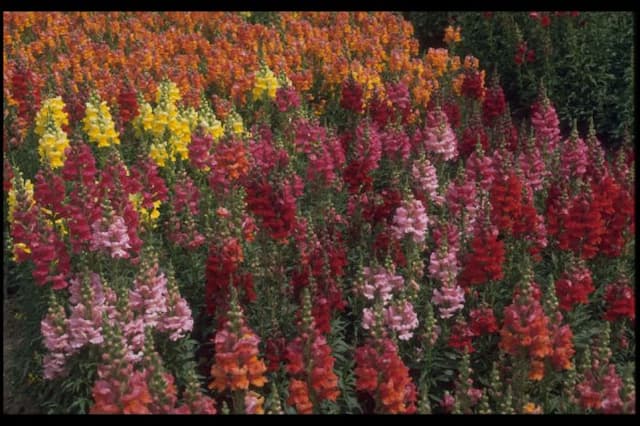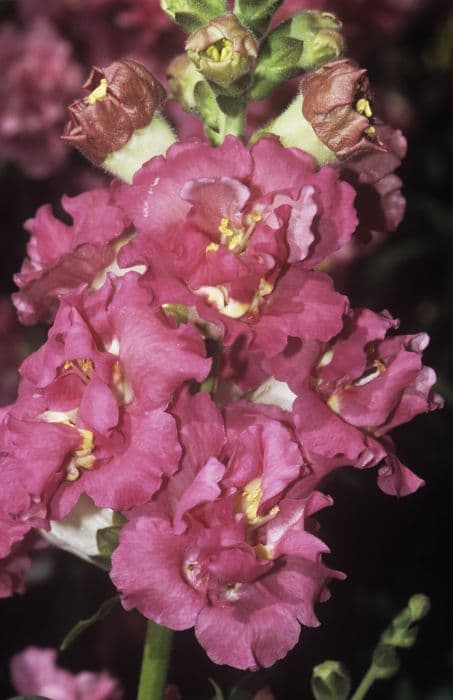Beardtongue Penstemon 'King George V'

ABOUT
Penstemon 'King George V' is a striking perennial known primarily for its vibrant flowers and attractive foliage. The plant boasts an abundance of tubular blossoms that typically come in a rich red hue, giving it a regal appearance befitting its name. These flowers are arranged in dense clusters atop upright stems that emerge from a base of lush green leaves. The leaves themselves are lance-shaped, with a somewhat glossy texture, and form a tidy mound at the base of the plant. When in bloom, Penstemon 'King George V' becomes a focal point in any garden due to the vivid contrast between its deep red flowers and the verdant foliage. This plant is a popular choice for gardeners looking to attract hummingbirds and other pollinators, as the flowers provide an excellent nectar source.
About this plant
 Names
NamesSynonyms
Beardtongue, King George V Penstemon
Common names
Penstemon 'King George V'.
 Toxicity
ToxicityTo humans
Penstemon, commonly known as beardtongue, is not typically considered poisonous to humans. There are no well-documented cases of toxicity from ingesting Penstemon 'King George V' or other Penstemon species. However, as with any plant, individual sensitivities can vary, so it's advisable to avoid ingesting plant parts unnecessarily. If someone were to ingest a large quantity and experience symptoms, it would be wise to consult a medical professional. Generally, though, Penstemon is regarded as safe and not associated with serious consequences following ingestion.
To pets
Beardtongue is not known to be toxic to pets either. There is a lack of evidence suggesting that Penstemon 'King George V' would cause harm to dogs, cats, or other household animals if they were to ingest parts of the plant. As with humans, it's still a good practice to prevent pets from consuming plants unnecessarily. If a pet does ingest beardtongue and shows any signs of distress, it’s best to contact a veterinarian, although serious toxicity is unlikely.
 Characteristics
CharacteristicsLife cycle
Perennials
Foliage type
Semi-deciduous
Color of leaves
Green
Flower color
Red
Height
2-4 feet (0.6-1.2 meters)
Spread
1-2 feet (0.3-0.6 meters)
Plant type
Herb
Hardiness zones
5
Native area
North America
Benefits
 General Benefits
General Benefits- Attracts Pollinators: This plant is known to attract bees, hummingbirds, and other beneficial pollinators to the garden.
- Drought-Tolerant: Once established, Penstemon 'King George V' is quite tolerant of dry conditions, making it suitable for water-wise gardens.
- Landscape Aesthetic: With its bright tubular flowers, this Penstemon adds vibrant color and visual interest to the landscape.
- Easy to Grow: It's a low-maintenance plant that can thrive in a variety of soil types, as long as they are well-draining.
- Long Blooming Season: The plant has a long flowering period, often blooming from late spring through summer, providing extended garden appeal.
- Deer Resistant: Generally, it is not a preferred plant by deer, which makes it an excellent choice for areas where deer browsing is an issue.
- Herbaceous Perennial: As a perennial, it will return year after year, making it a staple in garden planning and design.
 Medical Properties
Medical PropertiesThis plant is not used for medical purposes.
 Air-purifying Qualities
Air-purifying QualitiesThis plant is not specifically known for air purifying qualities.
 Other Uses
Other Uses- Art and Photography: Due to its vibrant blooms, the Penstemon 'King George V' provides a striking subject for botanical art and photography projects, capturing the vivid colors and intricate details of the flowers.
- Educational Tool: The plant can be used in educational settings, such as schools or botanical gardens, to teach about pollination, native plant species, and conservation efforts focused on preserving diverse plant life.
- Culinary Garnish: While not commonly consumed, the flowers can be used as a colorful, edible garnish for salads and desserts, assuming they are free from pesticides and other harmful chemicals.
- Ink and Dye Production: The pigments in the Penstemon 'King George V' flowers can be extracted to create natural inks or dyes for use in crafts or fabric dying.
- Perfumery: While not commonly known for its scent, the subtle fragrance of the flowers may be used in creating bespoke and niche perfumes.
- Flower Arranging and Bouquets: The stems and flowers of Penstemon 'King George V' are often used in flower arrangements, adding height and a touch of dramatic color to bouquets.
- Eco-friendly Confetti: Dried petals can be used as biodegradable confetti for outdoor celebrations, providing a sustainable alternative to plastic confetti.
- Symbolic Planting: It can be planted in memory gardens or given as a gift to symbolize affection and appreciation, as the vibrant flowers often represent cheer and warmth.
- Composting: After the blooming season, the plant material can be composted to create nutrient-rich soil amendments for garden beds and landscapes.
- Wildlife Photography Prop: The plant can be used as a prop or backdrop in wildlife photography, particularly when capturing images of the pollinators it attracts such as bees and butterflies.
Interesting Facts
 Feng Shui
Feng ShuiThe Beardtongue is not used in Feng Shui practice.
 Zodiac Sign Compitability
Zodiac Sign CompitabilityThe Beardtongue is not used in astrology practice.
 Plant Symbolism
Plant Symbolism- Charm and Attractiveness: With its beautiful, tubular flowers, Penstemon often symbolizes an attractive charm. The 'King George V' variety, with its royal name and striking appearance, emphasizes this symbolism.
- Hardiness and Adaptability: Penstemons are known for their hardy nature, able to survive in various climates and soils. This characteristic makes them symbolize resilience and adaptability in different life situations.
- Longevity: The enduring bloom period of the 'King George V' Penstemon throughout the summer represents longevity and long-lasting presence, both in gardens and in life.
- Health and Healing: Native American tribes historically used various Penstemon plants for medicinal purposes, so they can connote health and healing.
- Wealth and Royalty: The 'King George V' nomenclature might denote wealth and a regal status, relating to its namesake monarch, suggesting a standing of elegance and nobility.
 Water
WaterBeardtongue, commonly known as Penstemon 'King George V', should be watered deeply every week during hot and dry weather, aiming for about 1 inch of water each time, which is roughly 0.6 gallons for an average-sized plant. During cooler months or periods of rainfall, reduce watering frequency to avoid waterlogging. It's best to water this plant at the base to keep the foliage dry and prevent fungal diseases. Ensure the soil is well-draining and allow it to dry out slightly between waterings to promote strong root growth.
 Light
LightBeardtongue thrives in full sun and should be placed in a spot where it receives at least 6 to 8 hours of sunlight daily. Morning light with some afternoon shade can be beneficial in hotter climates to prevent leaf scorch. Avoid deep shade as it can lead to leggy growth and a reduction in flowering. Optimal lighting ensures healthy growth and abundant blooms for this plant.
 Temperature
TemperatureBeardtongue prefers a moderate temperature range and does well in a garden where the temperatures are typically between 60°F and 75°F. The plant can tolerate temperatures down to about 20°F but may suffer damage or die if temperatures drop below this point. High temperatures over 85°F may also stress the plant, so providing some afternoon shade in extremely hot climates can be beneficial.
 Pruning
PruningPruning Beardtongue is essential to encourage bushier growth, remove spent flower stalks, and maintain a neat appearance. Deadhead the flowers once they fade to stimulate a second bloom. In late autumn or early spring, cut back the plant's foliage to 1 to 2 inches above the ground to prepare for new growth. This yearly pruning helps prevent disease and ensures a vigorous plant.
 Cleaning
CleaningAs needed
 Soil
SoilBeardtongue 'King George V' prefers well-draining soil, a mix containing loam, sand, and a bit of compost is ideal. The soil pH should be slightly acidic to neutral, ranging between 6.0 to 7.0 for optimal growth.
 Repotting
RepottingBeardtongue 'King George V' should be repotted every 2-3 years to refresh the soil and address any root crowding. Ensure you use suitable soil mix and a pot that accommodates the plant's growth.
 Humidity & Misting
Humidity & MistingBeardtongue 'King George V' tolerates average humidity levels found in most homes and gardens, so no special humidity adjustments are necessary.
 Suitable locations
Suitable locationsIndoor
Ensure bright light, well-draining soil.
Outdoor
Full sun, well-drained soil, protect from harsh winds.
Hardiness zone
4-9 USDA
 Life cycle
Life cyclePenstemon 'King George V', commonly known as Beardtongue, starts its life cycle as a seed, which when sown, germinates to produce a small seedling. The seedling grows into a vegetative plant, developing a rosette of leaves at the base, and as it matures, it sends up flowering stems. Beardtongue flowers in late spring to early summer, showcasing tubular flowers that attract hummingbirds and pollinators. Once pollinated, the flowers produce capsules filled with small seeds. After seed dispersal, the plant may enter a period of dormancy, especially in regions with cold winters. With the arrival of warmer temperatures, the plant breaks dormancy, begins a new growth cycle, and may also spread vegetatively through rhizomes.
 Propogation
PropogationPropogation time
Spring-Early Summer
Penstemon 'King George V', commonly known as beardtongue, is often propagated through stem cuttings. The best time for this is in early summer when new growth is vigorous but not too woody. To propagate by cuttings, select a healthy stem with several sets of leaves. Cut a 4 to 6 inch piece, just below a leaf node, using a clean, sharp tool. Remove the leaves from the lower half of the cutting to expose the nodes where roots will form. The cutting can then be dipped in rooting hormone powder to encourage root development. Place the cutting in a well-draining potting mix, ensuring that the exposed nodes are below the soil surface. Water the cutting and keep it in a warm place with indirect light until roots have formed, which typically takes a few weeks. Once rooted, the cutting can be transplanted into a larger pot or into the garden.





![Snapdragon [Pretty in Pink]](/_next/image?url=https%3A%2F%2Fplants-admin.emdemapps.com%2Fimages%2Fplants%2F%2Fimages%2F604b5cb3b5385.png&w=640&q=75)



